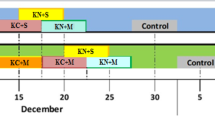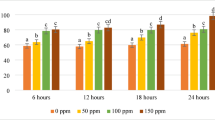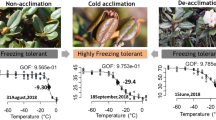Abstract
THE application of gibberellic acid to mature, fruiting shoots of Hedera was found1a,b to cause a reversion from the shrubby fruiting form to the juvenile vining type of growth. Our experiments have confirmed this response but indicate that it depends on the maintenance of a sufficiently high temperature following treatment.
This is a preview of subscription content, access via your institution
Access options
Subscribe to this journal
Receive 51 print issues and online access
$199.00 per year
only $3.90 per issue
Buy this article
- Purchase on SpringerLink
- Instant access to full article PDF
Prices may be subject to local taxes which are calculated during checkout
Similar content being viewed by others
References
Robbins, W. R., (a) Amer. J. Bot., 44, 743 (1957); (b) 46, 485 (1960).
Fisher, F. J. G., Nature, 173, 406 (1954).
Hudson, J. P., and Williams, I. M., Nature, 175, 814 (1955).
Njoku, E., New Phytol., 56, 154 (1957).
Doorenbos, J., Proc. Kon. Ned. Akad. Wetensch., Ser. C, 57, 99 (1954).
Stoutemyer, V. T., and Britt, O. K., Nature, 189, 854 (1961).
Author information
Authors and Affiliations
Rights and permissions
About this article
Cite this article
GOODIN, J., STOUTEMYER, V. Effect of Temperature and Potassium Gibberellate on Phases of Growth of Algerian Ivy. Nature 192, 677–678 (1961). https://doi.org/10.1038/192677b0
Issue date:
DOI: https://doi.org/10.1038/192677b0
This article is cited by
-
Responses of ivy (Hedera helix L.) to combinations of gibberellic acid, paclobutrazol and abscisic acid
Plant Growth Regulation (1990)
-
Anatomical Changes associated with Juvenile-to-Mature Growth Phase Transition in Hedera
Nature (1965)
-
Recent experimental studies of the shoot apex and shoot morphogenesis
The Botanical Review (1965)



